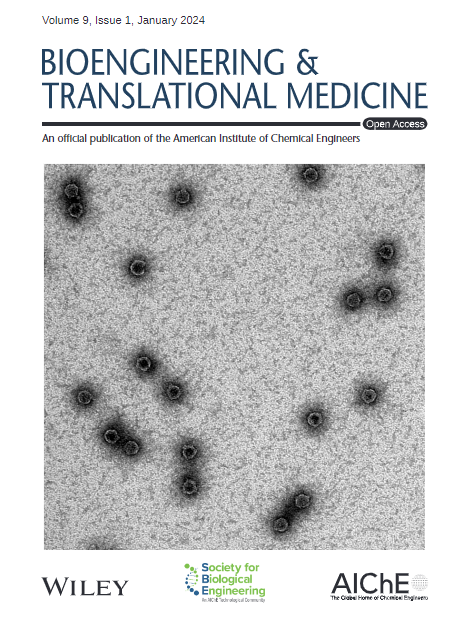Low‐cost, handheld, multi‐pulse electroporators for simplified nucleic acid delivery in skin
IF 5.7
2区 医学
Q1 ENGINEERING, BIOMEDICAL
引用次数: 0
Abstract
Electroporation‐mediated delivery offers a promising alternative to carrier‐based nucleic acid delivery methods for vaccination and therapeutic applications. Carrier‐based systems like lipid nanoparticles and viral vectors often suffer from poor in vivo stability, immunogenicity, toxicity, and off‐target effects. To overcome the high cost, bulkiness, lack of portability, and painful administration of traditional electroporators, we developed the RotoPatch family of small, low‐cost, hand‐held piezoelectric electroporators that use microneedle electrodes for intradermal delivery of nucleic acids. Notably, these RotoPatch devices use a single rotary motion to administer multiple electroporation pulses through microneedle electrodes, that localize the electric field to the upper layers of the skin. In animals, RotoPatch facilitated greater intracellular uptake of firefly luciferase‐encoded mRNA in mice and green fluorescent protein‐encoded plasmid DNA in rats, as confirmed by bioluminescence and fluorescence imaging, respectively. RotoPatch produced similar in vivo expression as electroporation using a manually actuated, multi‐pulse piezoelectric electroporator (ePatch) and a battery‐powered, multi‐pulse electroporator (eIgniter). These findings highlight the potential of multi‐pulse piezoelectric microneedle electroporation for intradermal nucleic acid delivery as a platform for gene therapy and vaccination.低成本,手持式,多脉冲电穿孔器,用于简化核酸在皮肤中的传递
电穿孔介导的递送为疫苗接种和治疗应用提供了一种有希望的替代基于载体的核酸递送方法。以载体为基础的系统,如脂质纳米颗粒和病毒载体,通常具有较差的体内稳定性、免疫原性、毒性和脱靶效应。为了克服传统电穿孔器的高成本、笨重、缺乏便携性和管理痛苦等问题,我们开发了RotoPatch系列小型、低成本、手持式压电电穿孔器,它使用微针电极进行核酸皮内递送。值得注意的是,这些RotoPatch设备使用单个旋转运动来通过微针电极施加多个电穿孔脉冲,从而将电场定位到皮肤的上层。在动物实验中,分别通过生物发光和荧光成像证实,RotoPatch促进了小鼠细胞内萤火虫荧光素酶编码mRNA和大鼠细胞内绿色荧光蛋白编码质粒DNA的摄取。RotoPatch使用手动驱动的多脉冲压电电穿孔器(ePatch)和电池供电的多脉冲电穿孔器(eIgniter)产生了与电穿孔相似的体内表达。这些发现突出了多脉冲压电微针电穿孔作为基因治疗和疫苗接种平台用于皮内核酸递送的潜力。
本文章由计算机程序翻译,如有差异,请以英文原文为准。
求助全文
约1分钟内获得全文
求助全文
来源期刊

Bioengineering & Translational Medicine
Pharmacology, Toxicology and Pharmaceutics-Pharmaceutical Science
CiteScore
8.40
自引率
4.10%
发文量
150
审稿时长
12 weeks
期刊介绍:
Bioengineering & Translational Medicine, an official, peer-reviewed online open-access journal of the American Institute of Chemical Engineers (AIChE) and the Society for Biological Engineering (SBE), focuses on how chemical and biological engineering approaches drive innovative technologies and solutions that impact clinical practice and commercial healthcare products.
 求助内容:
求助内容: 应助结果提醒方式:
应助结果提醒方式:


